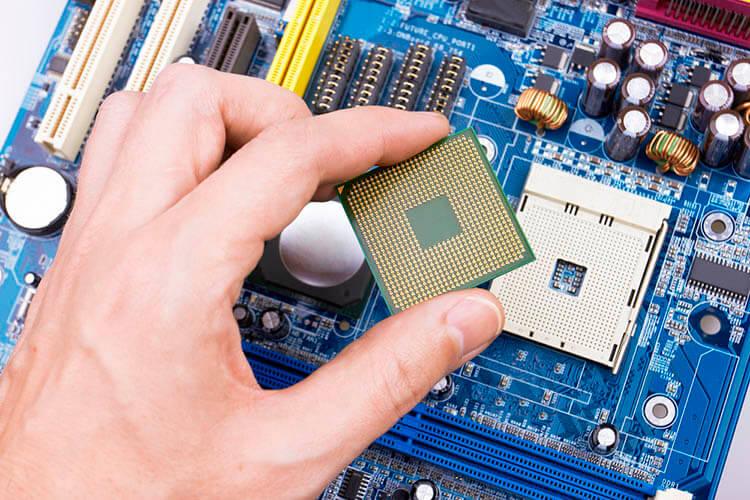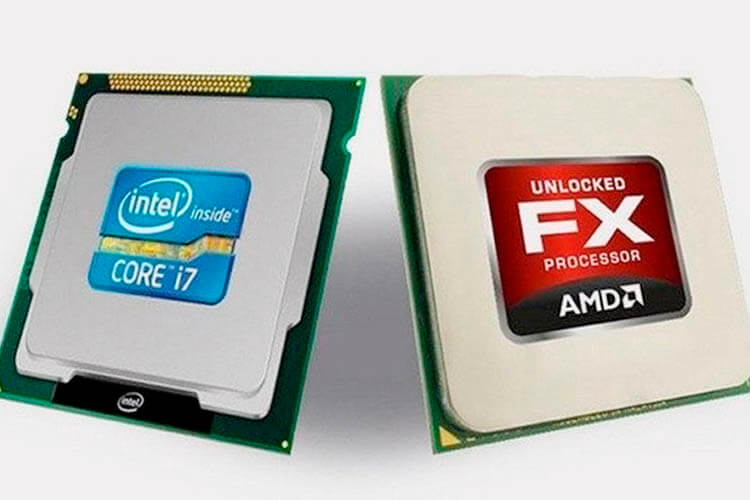Top 23 best processes: rating 2021-2022 and which processor is better to choose for gaming computer
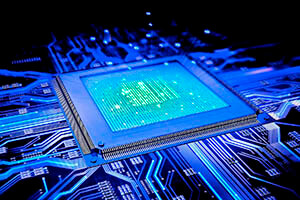 The processor is the brain of the computer, so it should be chosen with special responsibility, carefully analyzing all the characteristics.
The processor is the brain of the computer, so it should be chosen with special responsibility, carefully analyzing all the characteristics.
Nowadays, the top CPU manufacturers are two companies, which, while producing new products, try to rub each other's noses - the eternal leader Intel and its worthy competitor AMD.
The rating of powerful processors that have performed best in 2021-2022 was compiled on the basis of users' reviews and experts' evaluations. The performance, power, price and purpose of the chips were taken into account when compiling the TOP.
Rating TOP-23 best powerful processors 2021-2022
The rating includes the best gaming and professional processors according to experts and users. Here you can find both expensive and quite budget models.
| The place | Name | Price |
|---|---|---|
| Top 3 best performing processors in terms of price/performance in 2021-2022 |
||
| 1 | AMD Ryzen 9 3950X | |
| 2 | Intel Core i9-9900 | |
| 3 | AMD Ryzen 7 3800X | |
| Top 3 best Intel Core i9 processors | ||
| 1 | Intel Core i9-10900K | |
| 2 | Intel Core i9-10900KF | |
| 3 | Intel Core i9-9900KF | |
| Top 3 best powerful Ryzen 9 processors | ||
| 1 | AMD Ryzen 9 3900X | |
| 2 | AMD Ryzen 9 3900XT | |
| 3 | AMD Ryzen 9 5950X | |
| Top 3 best Intel Core i7 processors | ||
| 1 | Intel Core i7-10700K | |
| 2 | Intel Core i7-9700 | |
| 3 | Intel Core i7-7700K | |
| Top 3 best Ryzen 7 processors | ||
| 1 | AMD Ryzen 7 3700X | |
| 2 | AMD Ryzen 7 2700X | |
| 3 | AMD Ryzen 7 3800XT | |
| Top 3 best Intel Core i5 processors | ||
| 1 | Intel Core i5-9600KF | |
| 2 | Intel Core i5-10600K | |
| 3 | Intel Core i5-10400F | |
| Top 3 best performing Ryzen 5 processors | ||
| 1 | AMD Ryzen 5 3600 | |
| 2 | AMD Ryzen 5 3600X | |
| 3 | AMD Ryzen 5 3500X | |
| Top 2 best performing low cost processors | ||
| 1 | AMD Ryzen 5 3500 | |
| 2 | Intel Core i5-10400 | |
Synopsis of
- Top 23 best powerful processors for 2021-2022
- How to choose a powerful processor and what to look for?
- Top 3 best powerful processors by price/performance ratio
- Top 3 best Intel Core i9 processors
- Top 3 best performing Ryzen 9 processors
- Top 3 best Intel Core i7 processors
- Top 3 best Ryzen 7 processors
- Top 3 best Intel Core i5 processors
- Top 3 best performing Ryzen 5 processors
- Top 2 best performing low cost processors
- Which processor is better - AMD or Intel?
- Buyer reviews
- Conclusion and Conclusion
- Useful video
How to choose a powerful processor and what to look for?
When choosing a chip for a computer, laptop or a more compact device, there are several basic parameters to consider:
- Number of cores and threads - the more threads, the better. Even better if the number of threads exceeds the number of cores: then we speak of a multithreaded chip.
- Thermal processor .. Measured in nanometers, the smaller the number, the better.
- The operating (clock) frequency and the maximum frequency largely determines the speed of the chip.
- Heat dissipation and energy efficiency Determines how hot a processor will get under load and how much power it will consume.
- Cache size determines how much data can be stored in storage that needs to be accessed as quickly as possible.
- Availability of additional features and features, for example, an internal cooling system or integrated graphics.
Top 3 best powerful processors by price/performance ratio
AMD Ryzen 9 3950X
Top-of-the-line CPU with record-breaking 16 cores and 32 processing threads - premium CPU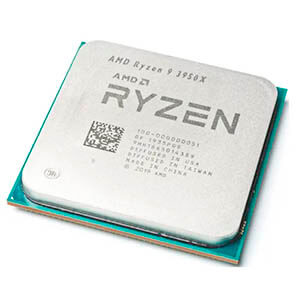
It features state-of-the-art TSMC 7nm process technology, updated chip design and unsurpassed performance. At the same time AMD managed to increase the number of cores without sacrificing operating frequencies or increasing power consumption.
The processor is recommended to use with dual-channel memory. It is based on three semiconductor chipset, one of which contains memory controller, PCI Express and SoC components. The crystal is devoid of NUMA nodes, due to which it has a monolithic design, and the functional CCD chipsets have no locked cores.
The core microarchitecture used is the innovative and already familiar from other AMD Zen 2 products. The chip is great for serious gamer systems, for working with heavy content and software in multitasking mode, for rendering and other tasks where maximum performance is required from the device.
Technical characteristics:
- number of cores/threads: 16/32;
- 7 nm process technology;
- clock frequency: 3500 MHz;
- maximum frequency: 4700 MHz;
- L3 capacity: 64 MB.
- top performance;
- speed;
- overclocking potential;
- power efficiency;
- operating temperature.
- price.
Intel Core i9-9900.
A very fast and reliable processor with 8 cores and 14nm process technology, which gradually replaces the more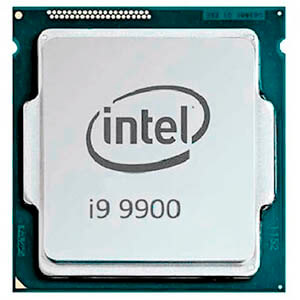
It is very powerful and shows good speed in operation, especially when it comes to complex computing tasks, running resource-intensive programs and a loaded gamer system.
Crystal is successfully used by those involved in 3D modeling. There is no need to flash the motherboard to install it as it is compatible with all 300-series chipsets and has a 1151 socket.
The technological process is listed as 14nm++, i.e. it is an improved process, slightly superior to the usual 14nm process in their usual sense. The operating frequency is 3100 MHz, but a single core is capable of overclocking up to 5000 MHz in most single threaded applications.
The processor is in perfect contact with dual channel DDR4-2666 RAM and has a 16MB L3 cache.
Technical characteristics:
- number of cores/threads: 8/16;
- TECHNOLOGY: 14 nm;
- clock speed: 3100 MHz;
- Maximum frequency: 5000 MHz;
- L3 capacity: 16 MB.
- performance;
- efficiency;
- thermal performance;
- integrated graphics.
- none detected.
AMD Ryzen 7 3800X.
The high-performance eight-core crystal with stable and fast performance is designed for gaming, home and
This CPU with 7nm process, 8 cores and 16 threads is compatible with socket AM4, features 32 MB cache and has a nominal clock speed of 3900 MHz.
The processor is unlocked for overclocking, but fans of overclocking should be warned at once about the heat dissipation exceeding the declared one. In tests, the chip was even hotter than the competitor from Intel with the declared TDP of 165 W.
The chip supports future generation PCIe 4.0 interface. It has no own graphics and needs the most powerful cooling system with at least two fans and an external gas pedal.
The manufacturer recommends DDR4-3200-memory for the processor, but in samples it integrated well and with higher frequencies (up to 3800 MHz).
Specifications:
- number of cores/threads: 8/16;
- Process: 7nm;
- clock frequency: 3900 MHz;
- Maximum frequency: 4500 MHz;
- L3 memory: 32 MB.
- power;
- manufacturability;
- memory controller;
- overclocks well.
- hot.
Top 3 best powerful Intel Core i9 processors
Intel Core i9-10900K
Intel's 10th generation platform with 10 cores and 20 compute threads and a locked multiplier.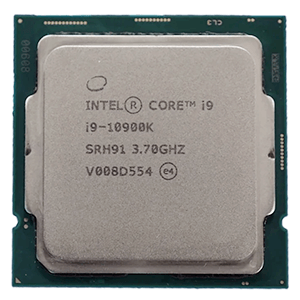
The model has a 20 MB cache and a high-performance 1200 socket, making it compatible with all 400-series chipsets. If you just buy it and install it with a quality cooling system, you get a good, powerful computer, but most of the potential remains untapped.
For a 10-core chip it has a rather modest clock speed and a small heat dissipation. To use the processor as intended, i.e. to take advantage of all its advantages, you will need to dig in the BIOS settings and spend money on a quality cooling system, preferably liquid type.
Technical specifications:
- Number of cores/threads: 10/20;
- Process technology: 14 nm;
- clock frequency: 3700 MHz;
- maximum frequency: 5300 MHz;
- L3 capacity: 20 MB.
- power;
- cache size;
- overclocking capability;
- integrated graphics.
- Requires expensive cooling.
Intel Core i9-10900KF.
The state-of-the-art tenth-generation stone of the Core i9 family goes on sale in April 2021-2022. It is designed for desktop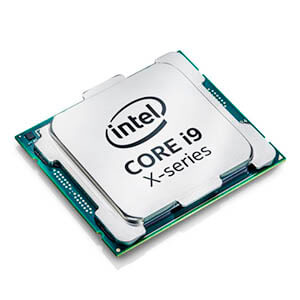
The performance and power of the device is determined by 10 cores and 20 processing threads. It is suitable for motherboards with socket 1200 and has proven itself as a reliable, powerful crystal for gaming and busy computing and multimedia systems.
There are two bundle options - OEM and BOX. In the second case, the kit comes with a cooling system, which is not able to cope with the heat dissipation of 125 W, much less the temperature to which the CPU heats up when overclocked to 5300 MHz. The platform needs a more serious cooler, preferably a liquid cooler.
Specifications:
- number of cores/threads: 10/20;
- process technology: 14 nm;
- clock speed: 3700 MHz;
- maximum frequency: 5300 MHz;
- L3 capacity: 20 MB.
- power;
- overclocking potential;
- Compatible with up to 128GB RAM.
- heat dissipation;
- price.
Intel Core i9-9900KF.
CPU for socket 1151 with an unlocked multiplier - the only Core i9-9900 family without an integrated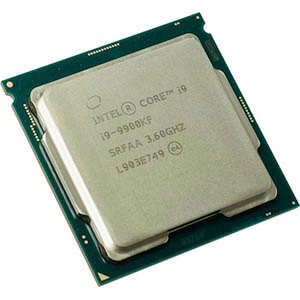
The processor is very sensitive to overclocking, and this immediately affects the operating temperature. It needs a good cooling system, preferably liquid, with two (at least) fans.
With a competent choice of cooler, the crystal is able to cope with any professional tasks, from 3D modeling to work with resource-intensive programs on a multi-component computer system.
In general, the CPU has good potential for overclocking and is great for those who like to upgrade their hardware. With the right approach, you can squeeze the maximum out of this crystal.
Technical specifications:
- number of cores/threads: 8/16;
- 14nm process technology;
- clock frequency: 3600 MHz;
- Maximum frequency: 5000 MHz;
- L3 capacity: 16 MB.
- performance;
- booster speed;
- stable power consumption;
- supports high-speed RAM modules.
- heats up.
Top 3 best powerful Ryzen 9 processors
AMD Ryzen 9 3900X.
A high-performance 12-core processor capable of processing up to 24 computing threads simultaneously, designed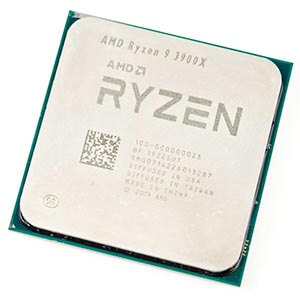
Now it is not a monolithic chip, but a crystal consisting of three semiconductor elements.
The first two are 7nm CCD chipsets and the third is a chipset based on 12nm process. The elements are connected to each other via an Infinity Fabric bus. Each CCX complex has one blocked core: this is done to increase the model's energy efficiency.
It beats its main competitor, the Intel Core i9-9900K, not only by the number of cores but also by cache size. Layer 3 storage has a capacity of 64 GB.
Clock speeds including overclocking are formally in the 3.8-4.6GHz range, but thanks to Precision Boost 2 the crystal is actually capable of more. However, if there is a need for frequencies close to the upper limit, you should splurge on a fan.
Technical specs:
- number of cores/threads: 12/24;
- Process: 7 nm;
- clock frequency: 3800 MHz;
- maximum frequency: 4600 MHz;
- L3 capacity: 64 MB.
- overclocks well;
- high performance;
- works out of the box.
- heats up.
AMD Ryzen 9 3900XT.
The prefix in the form of the letter T, which hides the prefix "turbo", reminds us that the frequencies compared to the previous generation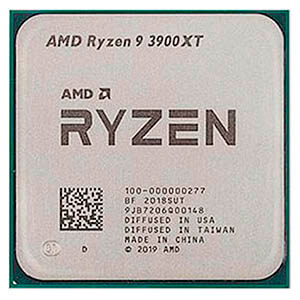
The processor comes in two packages - OEM and BOX, but even in the second case there is no cooler in the kit. This is due to the fact that the standard cooling system cannot cope with the declared TDP heat dissipation, and the chip will need a more powerful fan.
After installation the chip gets to work safely. It smoothly accelerates to optimal frequencies, under stress honestly reaches the declared maximum and ensures stable operation without much noise. When you overclock to higher frequencies the working temperature already reaches 90 degrees, so you can't do without a good cooling system.
If you have to choose between this variation and its predecessor, it is better to choose a stone with the prefix T: it is not much more expensive, but slightly more productive.
Technical specifications:
- number of cores/threads: 12/24;
- Process technology: 7 nm;
- Clock speed: 3800 MHz;
- maximum frequency: 4700 MHz;
- L3 memory: 64 MB.
- booster speed;
- stable power consumption;
- supports high-speed RAM modules.
- heats up.
AMD Ryzen 9 5950X.
The most powerful premium processor with 16 cores and support for 32 threads at an appropriate price should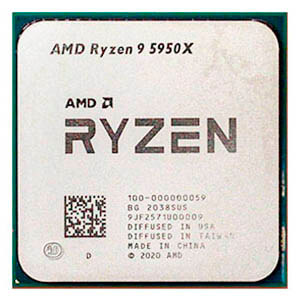
An interesting feature of the crystal is its ability to bypass the claimed maximum of 4.9 GHz in turbo mode, but under overload the clock frequencies do not reach even 3.4 GHz. Due to this feature the power consumption does not exceed 200 W, and the maximum temperature of the processor is 61 degrees.
Obviously, the modern 7nm process technology was chosen in the design. In addition to the third level cache with a capacity of 64 MB, impressive and the volume of L2 - 8 MB.
For this reason, Ryzen 9 3900XT can be called the most productive processor for desktop systems of professional level (3D-modeling, video editing, programming).
Technical specifications:
- number of cores/threads: 16/32;
- Process technology: 7 nm;
- clock frequency: 3400 MHz;
- Maximum frequency: 4900 MHz;
- L3 memory: 64 MB.
- performance;
- booster speed;
- stable power consumption;
- supports high-speed RAM modules.
- price;
- TDP.
Top 3 best Intel Core i7 processors
Intel Core i7-10700K
Stable and reliable octa-core chip with Comet Lake microarchitecture and advanced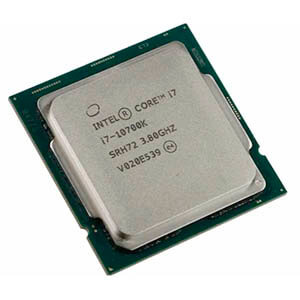
Despite a couple of pluses, this technological process in 2021-2022 is still considered outdated, because chips with 7nm process demonstrate much better performance. But for home systems with an average workload this option will do.
The processor is suitable for motherboards with socket 1200. It is good for those who don't want to upgrade and aim to run the processor out of the box. The BOX comes with a simple cooler and the device itself has its own graphics core.
By design it is a silicon platform with a small thickness, due to which a moderate heat dissipation is achieved and a more comfortable temperature mode is maintained.
In fact, the processor consists of 10 cores, two of which are disabled, which increases the area of the cooled surface, so the chip itself is cooler than its predecessors and even some successors (for example, Intel Core i9-9900K).
Technical specifications:
- number of cores/threads: 8/16;
- process technology: 14 nm;
- clock speed: 3800 MHz;
- maximum frequency: 5100 MHz;
- L3 capacity: 16 MB.
- Boost speed;
- DDR4 support up to 128GB;
- overclocking potential.
- hot;
- outdated technology process.
Intel Core i7-9700.
Budget, but reliable and stable octa-core with 14nm process without Hyper-threaning support designed for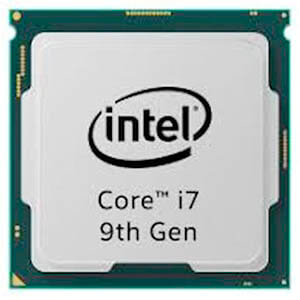
The clock speed is 3000 MHz and the maximum frequency is 4700 MHz. The platform is blocked for overclocking, and multithreading mode is not available. Along with this, the processor is stable in heat dissipation and does not heat up more than 70 degrees even under stress with a declared temperature maximum of 100 degrees.
The volume of the third level cache is 12 Mb. There is also its own Intel® UHD 630 graphics core and support for dual-channel RAM with a maximum capacity of 128 GB.
Users call the crystal a powerful and productive gaming platform, but compared to newer processors it is better left for universal home computers.
Specifications:
- number of cores/threads: 8/8;
- process technology: 14 nm;
- clock frequency: 3000 MHz;
- maximum frequency: 4700 MHz;
- L3 memory: 12 MB.
- built-in video core;
- cool;
- affordable;
- OEM cooler in the boxed version.
- outdated technology process.
Intel Core i7-7700K.
Quite productive and stable in operation processor for 1151 socket, designed on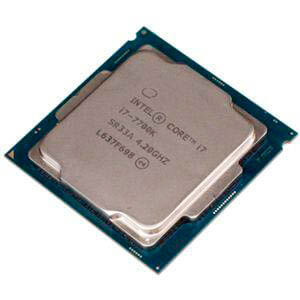
The platform supports Hyper-threaning technology and has four cores and eight computing threads, and differs from the previous brainchild of Intel, Core i7-7000, with slightly increased clock speed and unlocked multiplier.
The owner of this chip has 8 MB cache, good integrated graphics HD Graphics 630 and support for DDR4-2133/2400 and
DDR3L-1333/1600 memory up to 64GB.
Thanks to the unlocked multiplier, the processor is perfect for gaming systems. It easily overclocks up to 5 MHz and has significantly increased in performance compared to previous Intel chips.
Due to the 14 nm process and low voltage, the crystal has an optimal operating temperature and is quite cool with the appropriate cooling system.
Technical specifications:
- number of cores/threads: 4/8;
- process technology: 14nm;
- clock speed: 4200 MHz;
- maximum frequency: 4500 MHz;
- L3 memory: 8MB.
- stable in operation;
- good operating frequencies;
- cold;
- performance.
- Outdated technology process.
Top 3 best powerful Ryzen 7 processors
AMD Ryzen 7 3700X.
With the release of processors of this series AMD has planned to take over the processor market, or rather to take the leading position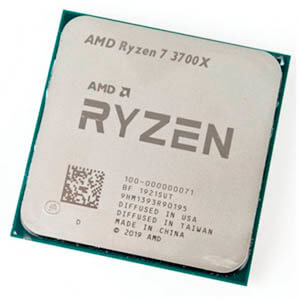
It is a complete eight-core platform with Zen 2 microarchitecture, with support for 16 computing threads for the AM4 socket.
The device has a roomy full-size third level cache of 32 MB and L2 cache with a capacity of 512 Kbytes per core. The declared base frequency of the processor is 3600 MHz, but in fact the crystal is overclocked up to 4.1-4.4 GHz due to the unique Precision Boost 2 overclocking technology.
The boxed cooler is not suitable for this processor if you plan to overclock the chip to the maximum: when working with Wraith Prism the temperature will significantly exceed the claimed 95 degrees, and this is the main disadvantage of the model.
Technical specifications:
- number of cores/threads: 8/16;
- Process: 7nm;
- clock speed: 3600 MHz;
- maximum frequency: 4400 MHz;
- L3 memory: 32 MB.
- cool;
- performant;
- fast;
- good at multithreading;
- economical.
- requires good cooling.
AMD Ryzen 7 2700X.
The second generation processor from AMD based on the 12nm Zen+ microarchitecture. Compared to what the corporation offered before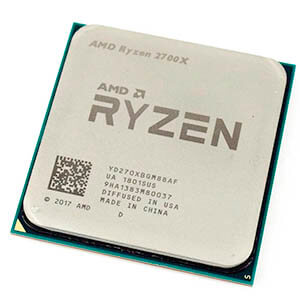
Due to this upgrade the maximum speed was slightly increased to 3700 MHz in normal mode and to 4300 MHz in boost mode, the overclocker potential was increased and the operating voltage was reduced.
The Precision Boost 2 algorithm was slightly modified to design this platform. Previously 1 or 2 threads could be boosted to maximum frequency. Now, more threads can run at higher frequencies, while speed reduction is smoother.
As a result, the maximum frequency even exceeds the claimed 4300 MHz.
A nice bonus for owners of Ryzen 7 2700X will be quality solder under the lid, due to which the operating temperature has become lower.
Specifications:
- number of cores/threads: 8/16;
- process technology: 12 nm;
- clock frequency: 3700 MHz;
- maximum frequency: 4300 MHz;
- L3 capacity: 16 MB.
- does not heat up;
- suitable for heavy gaming;
- good cooler included;
- quiet;
- price.
- were not detected.
AMD Ryzen 7 3800XT
Eight-core platform with SMT support for demanding users. It is designed on Matisse core and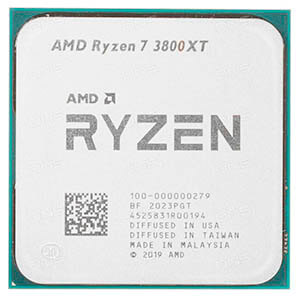
The L3 cache memory holds 32 MB of data, the base frequency is very good - 3900 MHz. The gain in operating frequency happened due to the use of improved 7nm TSMC process.
The TDP is 105W and power consumption is 142W. In case platform shows more energy efficiency, some cores achieve frequencies higher than declared in datasheet. In multithreading mode, the processor stably maintains a frequency of 4.2-4.4 GHz.
The platform design is a single CCD chip and IOD chip with PCI Express 4.0 buses, memory controllers and other input and output devices.
The only thing that can upset the buyer is the operating temperature of the processor. In games the crystal heats up to 74-78 degrees, in stress - and up to 80 degrees.
Specifications:
- number of cores/threads: 8/16;
- process: 7 nm;
- clock frequency: 3900 MHz;
- maximum frequency: 4700 MHz;
- L3 memory: 32 MB.
- powerful;
- fast;;
- stable;
- cool;
- Reaches the professional level.
- none.
Top 3 best powerful Intel Core i5 processors
Intel Core i5-9600KF.
Powerful, stable 6-core processor of ninth generation with support of 6 computing threads and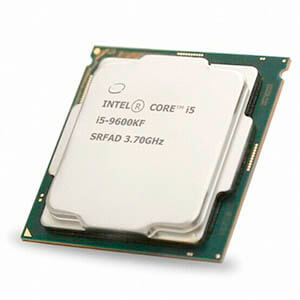
This is due to the high clock frequency of 3700 MHz and the ability to booster up to 4600 MHz, providing fast and smooth operation at maximum load. However, the processor can make distinctive noises and get very hot, so you should take care of a good cooling system.
The core is based on the Coffee Lake-S architecture. Users note its power even when running online shooters, including stable FPS without sags. Also, the stone supports dual channel DDR4 RAM with a frequency of 2666 MHz.
Technical specifications:
- number of cores/threads: 6/6;
- 14nm process technology;
- clock frequency: 3700 MHz;
- Maximum frequency: 4600 MHz;
- L3 capacity: 9 MB.
- Powerful for memory-hungry games and applications;
- fast;
- unlocked multiplier;
- You can use official overclocking software;
- price.
- Weak overclocking.
Intel Core i5-10600K.
Stable, powerful, cool 6-core Comet Lake processor with unlocked multiplier, integrated graphics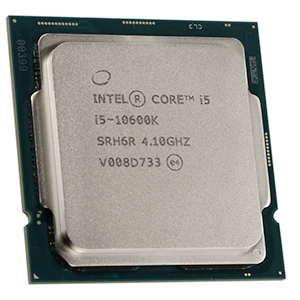
It is one of the most popular Intel processors for home and office, including 3D modeling, video editing and other demanding professional tasks.
Rated operating frequency of the platform is 4100 MHz, in turbo mode the stone is overclocked up to 4800 MHz. Heat dissipation at the same time is 125 W, but in the presence of a good fan in high load mode, the crystal does not heat up even to 60 degrees, and the TDP does not exceed 105 W.
The processor is compatible with the 1200 CPU socket and 400-series chipsets. It can work out of the box, but in the case of a gaming system, you'll need a good discrete graphics card. The built-in Intel UHD Graphics 630 won't handle the heavy modern graphics tasks.
Technical specs:
- number of cores/threads: 6/12;
- process technology: 14 nm;
- clock frequency: 4100 MHz;
- maximum frequency: 4800 MHz;
- L3 capacity: 12 MB.
- Intel vPro support;
- good frequencies;
- integrated graphics;
- cool.
- none detected.
Intel Core i5-10400F.
Six-core chip without integrated graphics, one of the best selling Intel products. Technically, the graphics core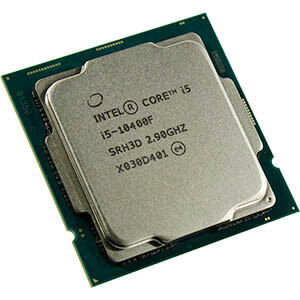
There are 12 threads in the platform, the L3 cache holds 12 MB. The device runs at 2900 MHz, overclocking to a maximum of 4300 MHz. At the same time it does not heat up much and does not strain with howling sound: it is quiet, powerful and well cooled. The maximum frequency is possible thanks to the built-in Turbo 2.0 technology.
In this model, Hyper-Threading technology appears for the first time. The manufacturer claims heating in operation up to 100 degrees, but tests have shown that even with the maximum load on the system the crystal does not get hotter than 60 degrees.
Specifications:
- number of cores/threads: 6/12;
- Process: 14nm;
- clock frequency: 2900 MHz;
- maximum frequency: 4300 MHz;
- L3 capacity: 12 MB.
- inexpensive;
- fast;
- built-in memory controller;
- cold.
- Blocked for overclocking.
Top 3 best powerful Ryzen 5 processors
AMD Ryzen 5 3600.
Simple, inexpensive, powerful six-core with SMT support, designed like Matisse, designed for motherboard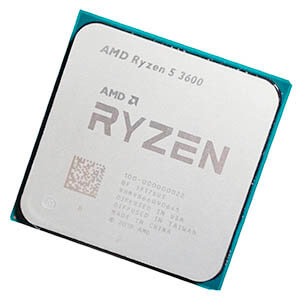
The platform supports DDR4 RAM with a frequency up to 3200 MHz. The stone itself under heavy load runs at a frequency of 3600 MHz, and in the boost overclocked to 4200 MHz. The performance and power indicators of this chip are significantly higher than those of its predecessors and competitors in this price segment.
The surprise for AMD fans was the TDP reduction from the usual 95W to the optimal 65W. This allows you to save on the cooling system and make do with a cheap air cooler.
Specifications:
- number of cores/threads: 6/12;
- process: 7 nm;
- clock frequency: 3600 MHz;
- maximum frequency: 4200 MHz;
- L3 memory: 32 MB.
- power;
- dynamics;
- budget;
- good stock cooler.
- none.
AMD Ryzen 5 3600X.
Powerful and very popular processor with 6 cores and 12 threads support is based on the thinnest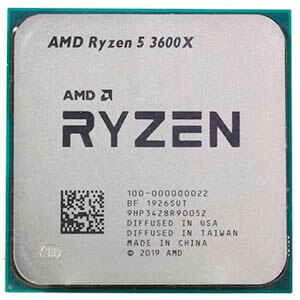
So, the cache memory allows access to 32 MB of data, the clock frequency is 3800 MHz - more than the maximum of some competitors. In the booster the platform is overclocked up to 4400 MHz, with a heat dissipation of 95 W.
In the boxed set you can find a standard Wraith Spire air cooler. Use it with the processor only if it is not intended for resource-intensive applications and will not be overclocked. With the latter, by the way, there is no problem: it starts smoothly and quite quickly reaches the maximum frequencies.
Technical specifications:
- number of cores/threads: 6/12;
- Process technology: 7nm;
- clock speed: 3800 MHz;
- maximum frequency: 4400 MHz;
- L3 memory: 32 MB.
- performance in all applications;
- booster speed;
- no heat;
- L3 capacity.
- none.
AMD Ryzen 5 3500X.
Inexpensive six-core processor for AM4 socket - productive, powerful, stable, cool, with excellent overclocking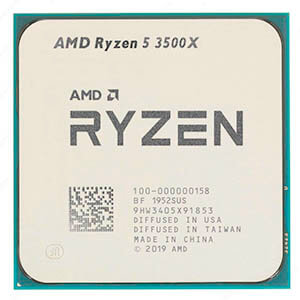
For the platform manufacturer has chosen the new Zen 2 microarchitecture at the time of production, thanks to which the performance of the stone has increased by 15% in total. There was also an increase in operating frequency: now the processor runs at 3.6 GHz in normal mode and accelerates up to 4.1 GHz in booster mode.
The processor runs on the modern 7nm process technology and differs from its predecessor by doubling the third level cache. The processor does not support multithreading and does not have SMT technology, but its clock frequency and L3 volume are enough for fast home system.
Technical specifications:
- number of cores/threads: 6/6;
- Process technology: 7nm;
- Clock speed: 3600 MHz;
- Maximum frequency: 4100 MHz;
- L3 memory: 32 MB.
- price;
- economy;
- quiet;
- working speed.
- none.
Top 2 best powerful low cost processors
AMD Ryzen 5 3500.
Simple, stable in operation and powerful processor with 6 cores Zen 2 and support processing up to 6 computing threads. The platform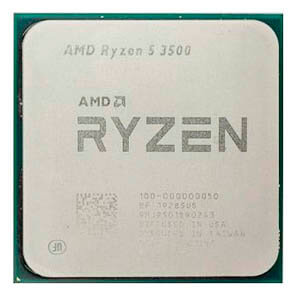
The manufacturer has given the chip a nominal operating frequency of 3.6 GHz and an unlocked multiplier. The tests showed that the processor easily overclocks up to the maximum 4.1 GHz with a smooth start and steadily maintains this frequency level with low heat dissipation and power consumption.
Combined with a good graphics card the processor is safe for gamers and professional machines for graphics processing, editing and 3D modeling. The chip supports dual-channel DDR4 RAM with a limit of 128 GB.
Technical characteristics:
- number of cores/threads: 6/6;
- process technology: 7 nm;
- clock speed: 3600 MHz;
- Maximum frequency: 4100 MHz;
- L3 memory: 32 MB.
- price;
- heat dissipation;
- economy;
- silent.
- none detected.
Intel Core i5-10400.
Low-cost six-core with Hyper-Threading support, optimal for all-in-one machines.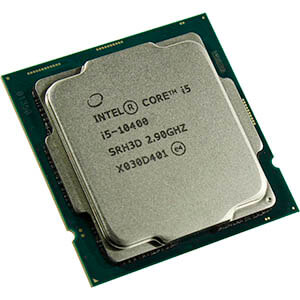
Nominal base frequency is 2.9 GHz, when Turbo Boost is activated the platform is overclocked up to 4-4.3 GHz, taking into account the number of overclocked cores. Under load, the 12 Mbytes L3 cache runs at 3.9-4.0 GHz.
The processor is reluctantly overclocked to maximum frequencies. In this case you will need to sacrifice some processes, so ideally you should not expect more than 4.1-4.2 GHz. The temperature stably stays at 50-55 degrees, with memory overclocking and voltage increase it rises only to 61 degrees.
On the whole, the performance of the chip is not bad due to 12 threads. The temperature is kept at a comfortable level under the cooling system. Since it is not strong in overclocking, it can be chosen for home computers and laptops, especially if there is a goal to save on the graphics card.
Technical specs:
- number of cores/threads: 6/12;
- process technology: 14 nm;
- clock speed: 2900 MHz
- maximum frequency: 4300 MHz;
- L3 capacity: 12 MB.
- energy efficiency;
- multithreading;
- Boost speed.
- Outdated technology process.
Which processor is better - AMD or Intel?
Looking ahead, we say that there is no answer to this question. Intel remains the most reliable and often chosen manufacturer in 2021-2022, because it is time-tested and has good ratings from experts and user reviews.
However, AMD is not going to retreat and sometimes announces such technologies and features, which allow to rub the competitor's nose in it. At the same time AMD processors are much cheaper.
Customer Reviews
Below are customer reviews of the models presented here:
Mikhail Litvinov, Intel Core i9-10900K:
Stable universal CPU, well overclocked in games and does not heat up. Tested on air and liquid cooling - equally cool in both cases. Very good memory handling, with a price lower than competitive crystals. I am satisfied!
Dmitry Zavyalov, AMD Ryzen 5 3600:
After the previous processor in this one is satisfied with everything, although before I worked exclusively with Intel. I'm really surprised by multithreading and power efficiency of this chip, it easily pulls all the games, doesn't get warm and doesn't consume any energy. I bought it with BOX bundle, just set it up and it works.
Conclusion and implications
Choosing the right processor for your PC will determine the power and usability of the whole computer system. In 2021-2022 the microprocessor market allows you to make a profitable purchase based on your needs and demands.
Useful video
How to choose the right processor for your gaming computer in 2021-2022:



